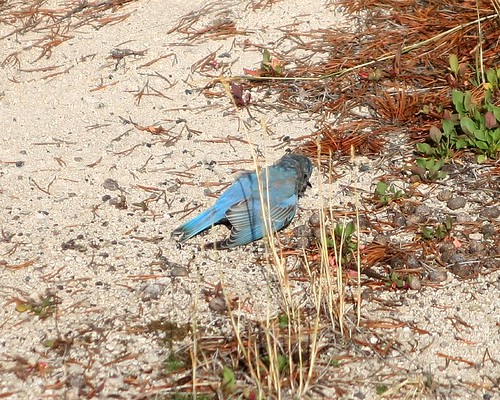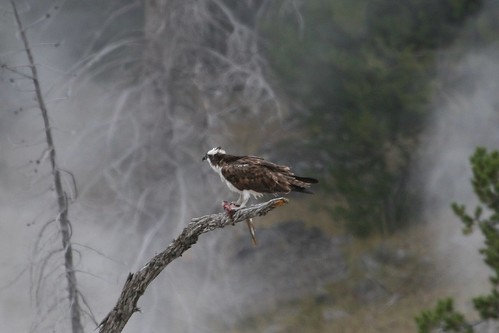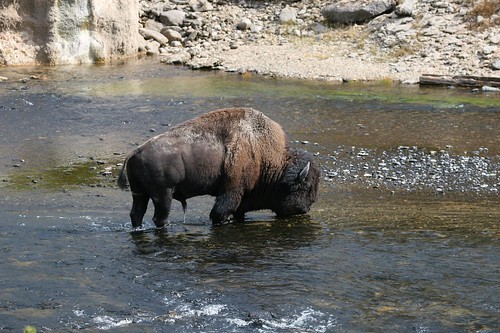After Tammy and I watched Old Faithful erupt, we hiked a five mile trail that explored Upper and Midway Geyser Basin. This trail was a mixture of gravel path and boardwalk that takes you past the myriad geothermal features in the area. This was an other-worldly place that smelled of hydrogen sulfide, was clouded by waves of steam, and was a confusing mix of warm wet air and cold dry air. In the middle of all of that, however, there were animals living out their lives, apparently ignorant of, or adjusted to, the volcanic workings of the area.
The first picture is of a Mountain Bluebird. These were fairly common, and their behaviors reminded me of the Eastern Bluebird that I am more familiar with. The second picture is of an Osprey eating a fish (I am assuming it is trout) while steam from some geothermal feature wafts by in the background. And the third picture is another American Bison, this one crossing Firehole River. The "rock wall" in the upper left corner of this picture is the outer wall of Riverside Geyser.
Showing posts with label Birds of Prey. Show all posts
Showing posts with label Birds of Prey. Show all posts
Scramble the Mudflats
One of the stops we made on my last field trip in Louisiana was at Lacassine NWR. The habitat there was mostly marsh and mudflats, attracting lots of ducks, wading birds and shore birds.
An interesting behavior exhibited by the shore birds occurred whenever a bird of prey would fly over the mudflats. The flocks of sandpipers would take off and fly around in a big "blob". In this particular example the bird of prey was a Peregrine Falcon (not in the picture). He appeared a couple of times, and each time the shore birds took off and flew around in their "blob", eventually landing again when the collective decided that the danger had passed. The guide for our field trip called this phenomenon "scrambling the mudflats" because after everything landed, you had to go through and re-identify/re-locate all the birds since they were all in different places than before.



An interesting behavior exhibited by the shore birds occurred whenever a bird of prey would fly over the mudflats. The flocks of sandpipers would take off and fly around in a big "blob". In this particular example the bird of prey was a Peregrine Falcon (not in the picture). He appeared a couple of times, and each time the shore birds took off and flew around in their "blob", eventually landing again when the collective decided that the danger had passed. The guide for our field trip called this phenomenon "scrambling the mudflats" because after everything landed, you had to go through and re-identify/re-locate all the birds since they were all in different places than before.



Red-shouldered Hawk
Some more photos from yesterday's visit to Lake Fausse Point State Park. The night before it rained quite a bit, so everything was wet the morning of our visit. Including the birds. The first photo shows a Red-Shouldered Hawk drying its wings. The second shows the same hawk sitting on its nest, with one hatchling visible (the white fuzzy thing to the right of the adult).




Mississippi Kite
Today's field trip started in Lake Fausse Point State Park. Right after getting off the bus, someone noticed this Mississippi Kite sunning himself in a tree right next to the parking lot. This was the first time I have ever seen a Mississippi Kite. The fact that he patiently posed for me to take pictures was even better.


Barred Owl
Owls are so cool. Whenever I see one I feel like it was a complete accident, or the owl decided that he wanted to be seen. That was how it happened today. I walked one of the trails in Acadiana Park when I just sort of looked up in a tree off to the right...and there was an owl watching me walk by. A Barred Owl, to be precise.


Aggressive Osprey
After visiting both Split Oak Mitigation Forest and Moss Park, I made a trip to Tibet-Butler Preserve. This is a chunk of land on the side of a lake. All other sides of the lake are being developed into subdivisions.
One trail within the Tibet-Butler Preserve takes you to the edge of the lake where you might get a glimpse of Ospreys. I managed to see not only an Osprey, but an Osprey that was, for whatever reason, showing some aggression towards an Anhinga.
I do not have a picture of the "victim" Anhinga prior to the incident, but he was perched at the top of a tree sunning himself. This picture of a different Anhinga shows what I mean.

This is a picture of the aggressor. In this case it is the Osprey that decided to dive-bomb the Anhinga perched at the top of a tree.
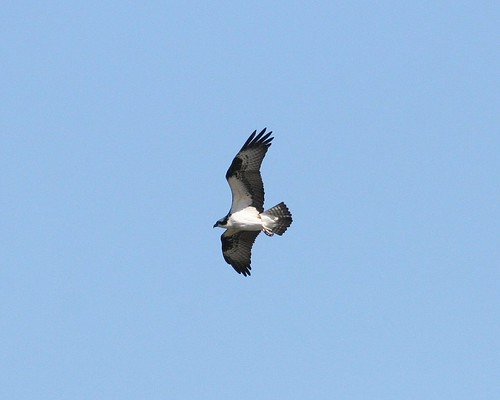
The result was captured in this picture. The poor Anhinga was doing everything it could to not fall all the way to the ground or swamp or whatever was at the bottom of the tree.

There was a happy ending. The Anhinga did manage to pull itself back up to a perched position. I just wish I had captured the impact where the Osprey actually knocked the Anhinga from its original perch.
One trail within the Tibet-Butler Preserve takes you to the edge of the lake where you might get a glimpse of Ospreys. I managed to see not only an Osprey, but an Osprey that was, for whatever reason, showing some aggression towards an Anhinga.
I do not have a picture of the "victim" Anhinga prior to the incident, but he was perched at the top of a tree sunning himself. This picture of a different Anhinga shows what I mean.

This is a picture of the aggressor. In this case it is the Osprey that decided to dive-bomb the Anhinga perched at the top of a tree.

The result was captured in this picture. The poor Anhinga was doing everything it could to not fall all the way to the ground or swamp or whatever was at the bottom of the tree.

There was a happy ending. The Anhinga did manage to pull itself back up to a perched position. I just wish I had captured the impact where the Osprey actually knocked the Anhinga from its original perch.
Warm March Saturday = DGCA
Today was an above average warm day in March. Even better, it was a Saturday and it was very sunny. If there was any downside to be discovered, it was the wind. It was quite windy today. So windy that it was sometimes annoying. For example, it can be hard to hold a camera on subject and keep it focused when the subject is flying around, and the wind is gusting hard enough to push you a bit, and you are using a 400mm lens.
Anyway, because it was so nice out, Tammy and I decided to visit Dutch Gap Conservation Area (DGCA). Actually, to be precise, I announced that I was going to DGCA last night and asked Tammy if she wanted to come along. She politely obliged. She tolerates me very nicely. And if you have not noticed yet, my "I am going bird watching at the last minute" location of choice in the Richmond area is DGCA.
Here are a couple pictures from the trip. The first is of a Red-shouldered Hawk. He was hanging out in a tree near the visitor center parking lot. If I remember correctly, there have been nesting Red-shouldered Hawks very near this parking lot the past two springs. As I walked below this particular hawk to take pictures, he watched me...well...like a hawk.
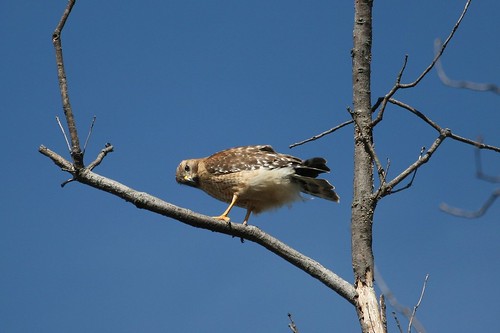
The second picture is of a festival of turtles. Or something like that. That log was quite the popular turtle sunning station. There were probably another four turtles, further to the right on this log, that had found spots to soak up the sun.

Anyway, because it was so nice out, Tammy and I decided to visit Dutch Gap Conservation Area (DGCA). Actually, to be precise, I announced that I was going to DGCA last night and asked Tammy if she wanted to come along. She politely obliged. She tolerates me very nicely. And if you have not noticed yet, my "I am going bird watching at the last minute" location of choice in the Richmond area is DGCA.
Here are a couple pictures from the trip. The first is of a Red-shouldered Hawk. He was hanging out in a tree near the visitor center parking lot. If I remember correctly, there have been nesting Red-shouldered Hawks very near this parking lot the past two springs. As I walked below this particular hawk to take pictures, he watched me...well...like a hawk.

The second picture is of a festival of turtles. Or something like that. That log was quite the popular turtle sunning station. There were probably another four turtles, further to the right on this log, that had found spots to soak up the sun.

Another Hawk
One of my weekend morning rituals is to sit in my study, sip coffee and read. I am not reading a newspaper (it has been years since I subscribed to one of those), but instead various things on the Internet. This morning, for example, I was researching Puerto Rico bird watching.
My study has a couple of windows that look out on my backyard. It is fairly common for me to see movement out of the corner of my eye as I sit reading at my computer. This is usually the squirrels chasing each other or some variety of songbird visiting my bird feeders. This morning, however, it was a bit different. I saw something larger fly by.
When I stopped reading to peer out the window, I saw a rather large bird perched on my fence. It was a hawk. I immediately ran to my kitchen to fetch my binoculars. When I got back, he was still there and one look told me it was not the Red-shouldered Hawk I took pictures of a couple weeks back. I had an idea of what it was, but was not sure. Instead of looking more to get the identification correct, I ran back to the kitchen to get my camera.
The camera already had the big lens on it, so I was ready to go. I pulled up the window blinds and then aimed the camera...nothing happened. Huh? Oh yeah...the memory card was on my desk. I quickly popped that into the camera and then realized that the camera's battery was dead. Sheesh. I had another on standby, so I fished that out and replaced the battery.
I was happy to see that the bird was still perched on the fence. I took a few pictures through the window, but this window was very dirty, and had a screen in it. I had pictures, but they were quite lame (so lame, they are not even posted on Flickr). So I moved one window to the right and was pleased that I still had a view of the bird. And this window did not have a screen in it (yes...my "to do" list at home is pretty long).
I managed to get a small number of reasonable pictures through the second window of my study. Here is one of them. The bird is an immature Cooper's Hawk. If you click through that link and read the description of a Cooper's Hawk, you will see "A medium-sized hawk of the forest, the Cooper's Hawk specializes in eating birds." My bird feeders might be attracting more than hungry song birds. Here is a link to another picture of a Cooper's Hawk that I found on the web that shows the tail from the back.

My study has a couple of windows that look out on my backyard. It is fairly common for me to see movement out of the corner of my eye as I sit reading at my computer. This is usually the squirrels chasing each other or some variety of songbird visiting my bird feeders. This morning, however, it was a bit different. I saw something larger fly by.
When I stopped reading to peer out the window, I saw a rather large bird perched on my fence. It was a hawk. I immediately ran to my kitchen to fetch my binoculars. When I got back, he was still there and one look told me it was not the Red-shouldered Hawk I took pictures of a couple weeks back. I had an idea of what it was, but was not sure. Instead of looking more to get the identification correct, I ran back to the kitchen to get my camera.
The camera already had the big lens on it, so I was ready to go. I pulled up the window blinds and then aimed the camera...nothing happened. Huh? Oh yeah...the memory card was on my desk. I quickly popped that into the camera and then realized that the camera's battery was dead. Sheesh. I had another on standby, so I fished that out and replaced the battery.
I was happy to see that the bird was still perched on the fence. I took a few pictures through the window, but this window was very dirty, and had a screen in it. I had pictures, but they were quite lame (so lame, they are not even posted on Flickr). So I moved one window to the right and was pleased that I still had a view of the bird. And this window did not have a screen in it (yes...my "to do" list at home is pretty long).
I managed to get a small number of reasonable pictures through the second window of my study. Here is one of them. The bird is an immature Cooper's Hawk. If you click through that link and read the description of a Cooper's Hawk, you will see "A medium-sized hawk of the forest, the Cooper's Hawk specializes in eating birds." My bird feeders might be attracting more than hungry song birds. Here is a link to another picture of a Cooper's Hawk that I found on the web that shows the tail from the back.

Backyard Hawk
Today was kind of a dreary slow day. It was gray, cloudy and eventually rained a little bit. It actually got cold enough for a little snow. When I write "a little", I mean it. I do not think I would have noticed had I not been outside at the time.
Why was I outside? Well, officially I was (and still am as I write this) procrastinating. I have some work that I must do this evening. I will not have time tomorrow morning and it is due tomorrow. My procrastination included me refilling the bird feeders and moving some trash from inside the house to the outside trashcans. It was when I was coming back in from these chores that I noticed a hawk sitting high up in a tree above my house.
After a couple trips in and out of the house (to fetch first binoculars, and then the camera with tripod), and relocating the bird after it flew into a tree in a neighbor's yard, I did manage to snap a few pictures. This was when the snow mentioned above actually occurred. When I took enough pictures for me to decide that it was not going to get any less fuzzy, and my fingers were getting cold quickly, I came in to complete my procrastination with this blog post. Oh, I almost forgot. This is a Red-shouldered Hawk.
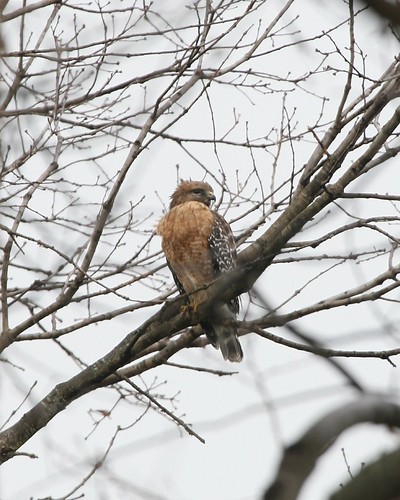
Why was I outside? Well, officially I was (and still am as I write this) procrastinating. I have some work that I must do this evening. I will not have time tomorrow morning and it is due tomorrow. My procrastination included me refilling the bird feeders and moving some trash from inside the house to the outside trashcans. It was when I was coming back in from these chores that I noticed a hawk sitting high up in a tree above my house.
After a couple trips in and out of the house (to fetch first binoculars, and then the camera with tripod), and relocating the bird after it flew into a tree in a neighbor's yard, I did manage to snap a few pictures. This was when the snow mentioned above actually occurred. When I took enough pictures for me to decide that it was not going to get any less fuzzy, and my fingers were getting cold quickly, I came in to complete my procrastination with this blog post. Oh, I almost forgot. This is a Red-shouldered Hawk.

Audubon Sanctuary


First thing this morning, we visited the Portland Audubon Sanctuary to do some birding. The birding was somewhat slow, but we did see a couple of birds that do not occur on the east coast. We also saw, however, some birds that do appear on the east coast. In one case, it took us forever to figure it out, and the other was pretty easy.
First, we have the simple Song Sparrow. I learned today that this species can look pretty different in the northwest compared to what I see back in Virginia. The first picture shows you how much darker this bird is out here (assuming you know what they look like back in Virginia).
The second photo is of a Barred Owl. I have seen this species back in Virginia, but seeing owls is such a treat, that I was quite happy to catch this guy hanging out while squirrels squeaked at him. The picture is a tad dark, but still pretty neat.
Subscribe to:
Posts (Atom)
